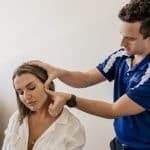The importance of exercise in healthy ageing

Article by Graceville Physiotherapist Matt Fowler
Physiological ageing is a normal aspect of life in which the human body experiences widespread systematic changes. As it relates to physiotherapy, many musculoskeletal changes may be observed, including a loss of balance, muscular strength, and dexterity, as well as a reduction in bone mineral density.
Many patients may simply accept this as their age ‘catching up’ with them and that changes in function are simply the new status quo, but appropriately implemented regimes of strength and endurance-based exercises can help improve functional capability and reduce the impacts of aging on the musculoskeletal system.
Sarcopaenia is characterised as an age related loss of muscle mass, the prevalence of which increases with age, ranging from 5-13% in those aged 60-70, up to 53% in those over the age of 80 [1]. Formal parameters for diagnosis of sarcopaenia include tests of walking speed, grip strength, and overall muscle mass. Regardless of a formal diagnosis of sarcopaenia, the majority of healthy people will lose up to 40% of their total muscle mass by the time they reach their 8th decade. This loss of muscle mass occurs primarily in the legs as opposed to the upper limbs, which makes these changes of seminal importance in regards to mobility [2]. In addition to a loss of muscle mass, there is a considerable change in the proportion of Type I and Type II muscle fibers as the body ages. Due to motor unit remodeling, the majority of fast twitch muscle fibers are converted into slow twitch Type I fibers, leading to a considerable reduction in capability for power generation [3].
Exercise is an essential aspect of healthy ageing and studies show that a whole range of different activities can be used to both reduce the loss of muscle fibers, as well as to build up strength in muscles with pre-existing weakness [4]. Circuit based exercise programs that involve a combination of both endurance exercises and strength exercises can lead to meaningful improvements in mobility and function in as little as 12 weeks [5]. Additionally, strength-based exercises that load the skeletal system help preserve bone mineral density [6]. These types of exercise programs are even shown to have significant positive improvements towards measures of mental health and wellbeing [7]. Whether these are exercise classes, or home programs, appropriate physical activity is a crucial aspect in not only management of mobility deficits observed with age, but also in prevention of such issues. As movement experts, physiotherapists can provide these programs to both pathological and healthy older adults as part of a multi-disciplinary management strategy.
Related Tag: Osteoporosis Treatment Brisbane, Seniors Exercise Classes
References:
1.Lexell J. Human aging, muscle mass, and fiber type composition. J Gerontol A Biol Sci Med Sci. 1995;50 Spec No:11–16. 2.Ciciliot S, Rossi AC, Dyar KA, Blaauw B, Schiaffino S. Muscle type and fiber type specificity in muscle wasting. Int J Biochem Cell Biol. 2013;45:2191–21993.Yoo SZ, No MH, Heo JW, et al. Role of exercise in age-related sarcopenia. J Exerc Rehabil. 2018;14(4):551-558 4. Lee MY, Jun WS, Lee MG. Effects of a 12-week circuit exercise program on fall-related fitness in elderly women with sarcopenia. Korean J Sports Sci. 2017;26:1123–1135. 5.Hong AR, Kim SW. Effects of Resistance Exercise on Bone Health. Endocrinol Metab (Seoul). 2018;33(4):435-444.6.Ferreira CB, Teixaria PDS, Santos GA, Maya ATD, …., Nobrega OT. Effects of a 12-Week. Exercise Training Program on Physical Function in Institutionalised Frail Elderly. Journal of Aging Research. 2018.


